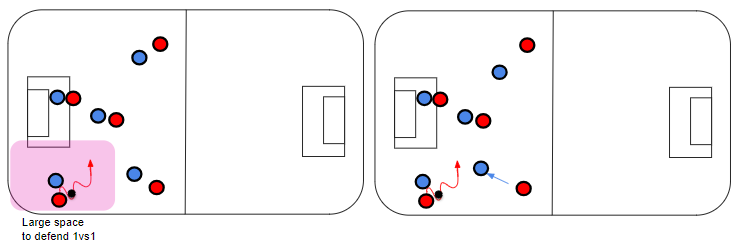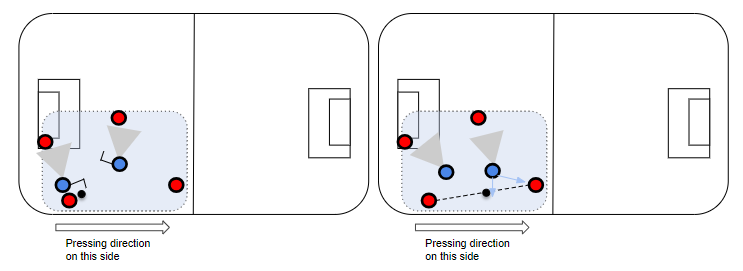Patterns of play that are more or less similar appear repeatedly in floorball as in other invasion team sports. They are emergent and thus cannot be predicted or predetermined. They happen in a chaotic environment as a result of coordinated interaction between the players and the environment mainly without central control. No single leader commands the whole team during the play. The team shares principles of play that they conform to (in addition to the rules of the game). These may be learned explicitly and/or implicitly – usually both. Ideally a particular pattern is an outcome of functional playing, not a mean to achieve a result.
Self-organization is a principle of complex adaptive systems that can explain such collective behaviour. The parts of a system organize themselves according to the information perceived from the environment and simple principles that they obey together. When the principles are functional and unambigious to each individual the system self-organizes itself as a whole. The team becomes more than the sum of its parts and has emergent properties that the individuals do not have.
According to the systems view, the essential properties of an organism or living system, are properties of the whole, which none of the parts have. They arise from the interactions and relationships among the parts. These properties are destroyed when the system is dissected, either physically or theoretically, into isolated elements. Although we can discern individual parts in any system, these parts are not isolated, and the nature of the whole is always different from the mere sum of its parts
-Fritjof Capra: The Web of Life
It is not enough to explicitly explain the principles to the players and walk through them a couple times. They need a lot of repetitions without repetition in a realistic context to learn the know-how of playing according to the principles. This way players learn to couple their perception (information) and action (movement) and can reflect on mistakes and successes. They need to be able to (inter)act under pressure in a limited time when there is less time for analysis. This implies also that it is important to keep along the principles in most of the team training and not separate perception and action.
Coaching the team according to playing principles implies the need to study the game deeply to form a game model that consists of explicit playing principles. Training is designed to teach playing according the principles both explicitly and implicitly. The environment should be representative of the game. Instead of simply demanding training hard and repetitions, the coach focuses on learning. Learning to play includes the technical and physical dimensions of course.
Floorball example
An example of a principle-based defensive organization that promotes self-organization according to local interactions could be as follows. This defensive system aims in minimizing the spaces to defend close to the opponents ball carrier. A well working and adaptive defensive organization may emerge even from a team with "less talented" defensive players this way.
“If I have to defend this whole garden, I’m the worst. If I have to defend this small area, I’m the best.” -Johan Cruyff
Defending principles for the defensive zone:
- Pressure the ball carrier on the defensive zone (assuming numerical balance)
- Every defender has an opponent on his responsibility (awareness of the positioning of the opponents players)
- Make gaps smaller close to the opponents ball carrier.
Sub-principles for these main principles:
- Direction of pressure: Try to steer the game towards the sides and out towards the opponents defensive zone
- Mark closely any opponents in the centre. Directly dangerous off-the-ball opponents are defended "man-based".
- Help the teammate who is challenged as much as you can without letting your own opponent free in a dangerous position. If your opponent is out in the corner or far away on their defensive zone, you may even double-team the ball carrier.
If a team learns these principles and their application well enough, the defense is able to adapt to the opponents offensive organization. Some kind of adaptation would anyway happen but this principle-based defense will allow the self-organization to happen without constraints of a defensive formation. The order in this system is dynamic, not static. Defending players get support from teammates and shouldn't have to defend a big space 1vs1 against the opponents ball carrier. The space behind the player defending the ball carrier and the gaps in between teammates close to ball is minimized which makes it more challenging for the opponents to find space to penetrate.

Moving the striker closer to the defender on the strong side is nothing new in floorball. With the principles of this example, if the ball is passed to the red defender on the strong side, the same forward should return to pressurize him. A common alternative is to move the weak side forward towards the centre but this might create a vicious cycle of compensations and exceptions.
According to the principles above, the striker may scale their supporting action to suit the situation. She makes the decision on how low to drop so that she still makes it in time to pressure her "own" opponent if a pass is made to her. For example, the blue defender needs more support against a very skillful dribbler – especially if the defender is positioned further away and does not shoot often or well. Instead of having constant formations and triggers for double-teaming "all-in", this organization leaves room for self-organization of the defensive formation.
The opponent is allowed to make some passes on the sides where the receiver is not directly dangerous. As the ball carrier is pressured, mistakes are more likely to happen and a bad pass may be intercepted or the receiver pressured immediately after one. Two players may double-team the ball carrier when all the opponents players are not posing urgent threat. The players make the decisions themselves, but they are thoroughly prepared and to conform to the shared principles.
Training the principles
The principles may be trained in different game scenarios from the whole 5vs5 game down. To model game-like repetitions, a simple 4vs2 rondo could be used as an example. The players off-the-ball (blue) are coached to defend according to the team principles:
- The player pressuring the ball carrier tries to steer the movement and passes away from the corner
- She will try to take away the option to pass the ball towards the end of the defensive zone.
- The second blue player drops close enough to close the gap in between the blue players and cut the pass to the centre
- She will try to cut passes or "arrive with the ball" to pressure the red player close to the middle line of the field

By comparing the game situation above and this example of a rondo exercise we can observe similarity between them. Now the players get to practice their skills with specificity to the game and get repetitions with a clear purpose. They can adjust their technical and physical actions to the opponents (as well as the teammates) and learn to couple their perception and action better during the process. The team learns interpersonal coordination as the players get used to each others ways of interacting in these situations. Training happens in a playful and competitive environment to engage emotions.
Other rondo or positional play exercises may also be built to suit the needs of an individual team, coach and specific players. Teammates and opponents may be added and the playing area modified to adjust the skill level needed, physical actions profile or complexity of the training. For example a progression could be using of a 5vs3 exercise (4+1 vs 3) to move towards the whole game situation.
Now the team may also self-organize to play a more compact defense against a strong opponent and maybe spread a little more to give pressure faster against a weaker team. As the spaces to defend are constantly made small collectively, even less talented defenders may succeed in their objective. This is an emergent property because it is specific to the team that is organized this way. It is a result of interactions between players, not only players learning individual skills or improving their properties. Not saying they wouldn't improve and learn those properties and skills while training this way.
Disclaimer: this is not an attempt to define a "correct" way to defend, just an example of a defensive organization that is based less in individual execution of a system and more in flexible interaction and cooperation between teammates.
Deep simplicity
With a coaching and learning process according to principles of complex adaptive systems, achieving transfer into the match performance might become simpler (though maybe not "easier") than the reductionist manner of separating physical, technical, tactical and mental dimensions and individuals. The principles of self-organization and emergence are intuitively quite appropriate to understand an invasion team sport phenomena. There is even research showing how basketball teams and games have similarities to self-organizing systems of the nature.
"Many researchers consider basketball to be a random sport (according to a Poisson probability distribution), but the reality is actually much more complex, just as in natural systems," -Yves de Saá Guerra
“If the world is complex, then acting congruently with that complexity can be simpler than trying to control a machine that does not exist.” ―Embracing Complexity
“We need another paradigm that informs us to make better decisions.” -Jean Boulton
According to the complexity paradigm, a team really may act as a whole, may be observed that way and can have its own collective intelligence. The team should also be coached as more than individuals – training interaction, not just action.
Antti Hänninen (@AjHanninen)
References/Links:
Basketball games mimic nature: https://www.sciencedaily.com/releases/2016/03/160330123454.htm
Collective intelligence: An incursion into the tactical performance of football teams
http://www.human-current.com/episode-075-embracing-complexity-an-interview-with-jean-boulton
A short video giving an overview to the term self-organization https://www.youtube.com/watch?v=Kllwof87kR0
Glossary
Emergence = Emergence occurs when "the whole is different from the sum of the parts". Interactions between the parts of a system and the environment allow the system to develop properties that the individuals do not have.
Self-organization = Larger scale order arises from local interactions between the parts of a system and its environment
Complex adaptive system = A system that cannot be understood by looking at the parts only. Such system is capable of self-organization, learning and evolution.
